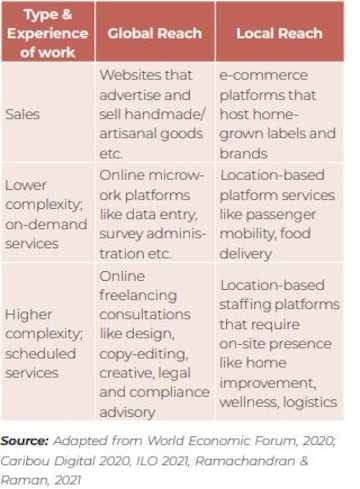
India's gig workforce is likely to expand to 2.35 crore by 2029-30 from 77 lakh in 2020-21, according to a NITI Aayog report released on Monday. The group is expected to form 4.1 percent of total livelihood in India by 2029-30.
A recent report by Taskmo, a Quess Corp company, stated that quick commerce, health tech, fintech, and e-commerce were the top sectors in the Indian gig space and Gen Z and millennials constitute 48 percent of the gig economy.
Within the gig workforce, work-from-home jobs account for 33 percent of the roles and 67 percent were on-field roles.
The highest demand was recorded for sales and marketing roles, according to the Taskmo Gig Index (TGI), a tool to measure the demand and supply for gig work across India.
But who are gig workers?
Gig workers are those engaged in livelihoods outside the traditional employer-employee arrangement, according to the NITI Aayog report titled 'India's Booming Gig and Platform Economy'. They can be broadly classified into two categories — platform and non-platform-based workers.
Platform workers are those whose work is based on online software apps or digital platforms. Non-platform gig workers are generally casual wage workers and own-account workers in the conventional sectors, working part-time or full time, the report said.
Types of digital livelihood, and where platform work falls

Between 2010 and 2018, mobility aggregators – Ola and Uber – alone were reported to have unlocked 2.2 million platform job opportunities in the country, according to the report. These included driving jobs using taxi-cabs, auto-rickshaws, and the ubiquitous two-wheelers (scooters and motorbikes) as taxis.
Though there exists no official data that can authoritatively estimate the extent of gig work in India, the report states that, at present, about 47 percent of the gig work is in medium-skilled jobs, about 22 percent in high-skilled jobs, and about 31 percent in low-skilled jobs.
High-, medium- and low-skilled gig workforce
Prashant Janadri, co-founder at Taskmo, an on-demand gig talent discovery platform backed by Quess Corp, explained that high-skilled workers include roles such as independent consultants, administrative assistants, graphic designers, substitute instructors, tutors, content writers, and engineers, etc.
Medium-skilled workers are electricians, carpenters, beauticians, construction workers, telecallers, etc., he said. Low-skilled gig workers include cab drivers, delivery executives, pickers and packers, among others, he added.
Also Read: NITI Aayog bats for gig workers — suggests paid sick leave, insurance, retirement plans for all
“Trend shows the concentration of workers in medium skills is gradually declining and that in low skills and high skills is increasing. It may be expected that while the domination of medium skills would continue till 2030, gig work with other skills will emerge,” the NITI Aayog report stated.
These roles are in most demand
According to Taskmo's May data, on the back of growing marketing and sales across segments, job profiles such as business development executives (500 percent), field sales executives (374 percent), digital promoters (200 percent), brand promoters (75 percent), and micro-influencers (50 percent) have seen a huge spike in demand for the gig segment.
"With the post-pandemic reset, more and more companies are hiring freelancers for such job roles in the hopes of meeting yearly targets," it added.
Last-mile delivery executives also witnessed a remarkable 302 percent increase in demand over the past month, while demand for telecallers increased by 247 percent, the Quess company said in a statement.
"There is a surge in demand for these roles as the pandemic has led to a boom in the way businesses operate, catering to the growing demand for utilising the expertise and benefits associated with the gig workers. Short-term approach as the source of income over the full-time employment was the utmost choice for all the upcoming workers," Janadri told CNBCTV18.com.
For roles in top demand like business development executives, and telecallers, the right candidates need to have interpersonal, networking, and communication skills. They should know regional languages and must have leadership qualities and a learning approach.
How much are gig workers paid?
Gig workers are mainly paid on the outcome-based model, meaning they are remunerated for the number of tasks they do i.e., on a task basis or monthly basis like every other full-time employee.
The salary differs based on the task and the time required for it but roughly ranges between Rs 500 and Rs 2,000 per day, Taskmo’s Janadri said.
Check out our in-depth Market Coverage, Business News & get real-time Stock Market Updates on CNBC-TV18. Also, Watch our channels CNBC-TV18, CNBC Awaaz and CNBC Bajar Live on-the-go!


Will the payment under PM-KISAN be increased? Here's what Finance Minister said
Apr 18, 2024 3:58 PM
First phase of voting for Lok Sabha elections begins tomorrow, 1,625 candidates in fray
Apr 18, 2024 3:50 PM
Tamil Nadu Lok Sabha elections 2024: Full list of BJP candidates
Apr 18, 2024 2:37 PM
Tamil Nadu Lok Sabha elections 2024: Seats, schedule, DMK candidates and more
Apr 18, 2024 1:34 PM

